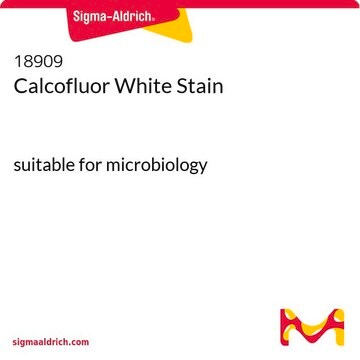Mayer's Mucicarmine Stain Solution is used to detect epithelial mucins and mucins secreting adendocarcinomonas and to demonstrate Cryptococcus neoformans and other fungi. The staining procedure involves placing a drop of the solution on a clean slide, then preparing and observing the stained fungal culture under a microscope.
41325
Mayer′s Mucicarmine Stain Solution
for microscopy
Sinónimos:
Mucicarmine Stain Solution according to Mayer
Seleccione un Tamaño
63,30 €
Seleccione un Tamaño
About This Item
63,30 €
Productos recomendados
grado
for microscopy
Nivel de calidad
Línea del producto
BioChemika
Formulario
liquid
caducidad
limited shelf life, expiry date on the label
técnicas
microbe id | staining: suitable
idoneidad
suitable for microscopy
fungi
aplicaciones
food and beverages
hematology
histology
temp. de almacenamiento
room temp
Categorías relacionadas
Descripción general
Componentes
Carmine 1 g, Aluminum chloride 0.5 g, water 2 ml
Palabra de señalización
Danger
Frases de peligro
Consejos de prudencia
Clasificaciones de peligro
Eye Dam. 1 - Skin Corr. 1B
Riesgos supl.
Código de clase de almacenamiento
8B - Non-combustible corrosive hazardous materials
Clase de riesgo para el agua (WGK)
WGK 1
Punto de inflamabilidad (°F)
Not applicable
Punto de inflamabilidad (°C)
Not applicable
Equipo de protección personal
Faceshields, Gloves, Goggles, type ABEK (EN14387) respirator filter
Elija entre una de las versiones más recientes:
¿Ya tiene este producto?
Encuentre la documentación para los productos que ha comprado recientemente en la Biblioteca de documentos.
Los clientes también vieron
-
What is the Protocol for using Mayers Mucicarmine 41325 for staining fungi?
1 respuesta-
¿Le ha resultado útil?
-
-
Please provide the protocol for histology
1 respuesta-
Formulation 41325 contains carmine (1 g), aluminum chloride (0.5 g), and water (2 ml). On the other hand, the formulation for HT3018 consists of certified carmine (10 g/L), aluminum hydroxide (10 g/L), and aluminum chloride (5 g/L) in ethanol (50% w/v), following Southgate's modification of Mayer's mucicarmine procedure. Dilution instructions for use are provided, indicating the need to dilute product 41325 with either 10 volumes of distilled water or preferably 50-70% alcohol just before use.
¿Le ha resultado útil?
-
Filtros activos
Nuestro equipo de científicos tiene experiencia en todas las áreas de investigación: Ciencias de la vida, Ciencia de los materiales, Síntesis química, Cromatografía, Analítica y muchas otras.
Póngase en contacto con el Servicio técnico











